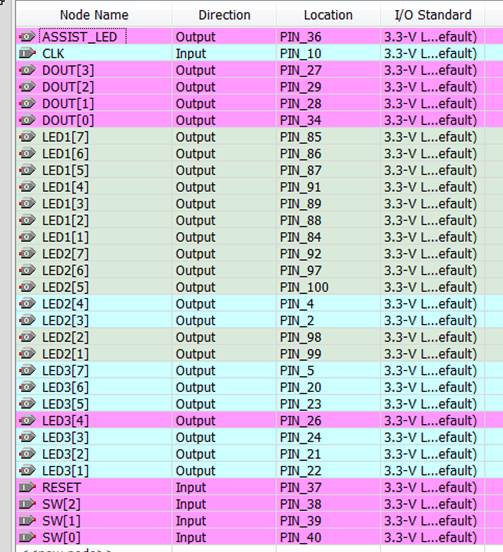今まで作ったパーツを元にルーレットを組み立てていきます。
まず、いままでのパーツの復習は以下のとおりです。
divider.vhd
oneshot.vhd
slot.vhd
roullet.vhd
reach.vhd
reach_ctl.vhd
bingo_ctl.vhd
ring.vhd
bingo_ast.vhd
dec_7segled.vhd
何やらいっぱいある感じですが、機能に分割しているからです。
で、トップエンティティは次になります。
slot_game.vhd
-- SLOT TOP Entity
library IEEE;
use IEEE.STD_LOGIC_1164.ALL;
entity SLOT_GAME is
port(
CLK : in std_logic;
RESET : in std_logic;
SW : in std_logic_vector(2 downto 0);
LED1 : out std_logic_vector(7 downto 1);
LED2 : out std_logic_vector(7 downto 1);
LED3 : out std_logic_vector(7 downto 1);
DOUT : out std_logic_vector(3 downto 0);
ASSIST_LED : out std_logic
);
end SLOT_GAME;
architecture RTL of SLOT_GAME is
component DIVIDER
port(
CLK : in std_logic;
DIV_CLK_2HZ : out std_logic;
DIV_CLK_8HZ : out std_logic;
DIV_CLK_16HZ: out std_logic
);
end component;
component SLOT
port(
DIV_CLK : in std_logic;
RESET : in std_logic;
SW : in std_logic;
STOP_OUT : out std_logic;
HIT : out std_logic_vector(3 downto 0)
);
end component;
component REACH_CTL
port(
REACH_CLK: in std_logic; -- リーチ状態の点滅用クロック
STOP1 : in std_logic; -- ルーレットが 0:動 1:止
STOP2 : in std_logic; -- ルーレットが 0:動 1:止
STOP3 : in std_logic; -- ルーレットが 0:動 1:止
HIT1 : in std_logic_vector(3 downto 0);
HIT2 : in std_logic_vector(3 downto 0);
HIT3 : in std_logic_vector(3 downto 0);
LED_CLK1 : out std_logic; -- 7SegLEDの点滅クロック
LED_CLK2 : out std_logic; -- 7SegLEDの点滅クロック
LED_CLK3 : out std_logic -- 7SegLEDの点滅クロック
);
end component;
component BINGO_CTL
port(
RESET : in std_logic;
STOP1 : in std_logic; -- ルーレットが 0:動 1:止
STOP2 : in std_logic; -- ルーレットが 0:動 1:止
STOP3 : in std_logic; -- ルーレットが 0:動 1:止
HIT1 : in std_logic_vector(3 downto 0);
HIT2 : in std_logic_vector(3 downto 0);
HIT3 : in std_logic_vector(3 downto 0);
BINGO_STATUS: out std_logic -- BINGO 0:× 1:○
);
end component;
component BINGO_AST
port(
STOP1 : in std_logic; -- ルーレットが 0:動 1:止
STOP2 : in std_logic; -- ルーレットが 0:動 1:止
STOP3 : in std_logic; -- ルーレットが 0:動 1:止
HIT1 : in std_logic_vector(3 downto 0);
HIT2 : in std_logic_vector(3 downto 0);
HIT3 : in std_logic_vector(3 downto 0);
BINGO_ASSIST: out std_logic -- BINGO_ASSIST の点滅
);
end component;
component RING
port(
DIV_CLK : in std_logic;
ENABLE : in std_logic;
DOUT : out std_logic_vector(3 downto 0)
);
end component;
component DEC_7SegLED
port(
ENABLE : in std_logic;
RESET : in std_logic;
COUNTER : in std_logic_vector(3 downto 0);
LED_7SEG : out std_logic_vector(7 downto 1)
);
end component;
signal CLK_2HZ : std_logic;
signal CLK_8HZ : std_logic;
signal CLK_16HZ : std_logic;
signal STOP : std_logic_vector(2 downto 0);
signal HIT1_TMP : std_logic_vector(3 downto 0);
signal HIT2_TMP : std_logic_vector(3 downto 0);
signal HIT3_TMP : std_logic_vector(3 downto 0);
signal BINGO_STATUS : std_logic;
signal LED_TMP : std_logic_vector(2 downto 0);
begin
U1:DIVIDER port map (CLK,CLK_2HZ,CLK_8HZ,CLK_16HZ);
S1:SLOT port map (CLK_16HZ,RESET,SW(0),STOP(0),HIT1_TMP);
S2:SLOT port map (CLK_16HZ,RESET,SW(1),STOP(1),HIT2_TMP);
S3:SLOT port map (CLK_16HZ,RESET,SW(2),STOP(2),HIT3_TMP);
U2:REACH_CTL port map (CLK_2HZ,STOP(0), STOP(1), STOP(2), HIT1_TMP,HIT2_TMP, HIT3_TMP,LED_TMP(0), LED_TMP(1), LED_TMP(2));
U3:BINGO_CTL port map (RESET,STOP(0), STOP(1), STOP(2), HIT1_TMP,HIT2_TMP, HIT3_TMP,BINGO_STATUS);
U4:BINGO_AST port map (STOP(0),STOP(1), STOP(2), HIT1_TMP,HIT2_TMP, HIT3_TMP,ASSIST_LED);
U5:RING port map (CLK_16HZ,BINGO_STATUS,DOUT);
D1:DEC_7SegLED port map (LED_TMP(0),'1',HIT1_TMP,LED1);
D2:DEC_7SegLED port map (LED_TMP(1),'1',HIT2_TMP,LED2);
D3:DEC_7SegLED port map (LED_TMP(2),'1',HIT3_TMP,LED3);
end RTL;
ここで、次のように
D1:DEC_7SegLED port map (LED_TMP(0),'1',HIT1_TMP,LED1);
D2:DEC_7SegLED port map (LED_TMP(1),'1',HIT2_TMP,LED2);
D3:DEC_7SegLED port map (LED_TMP(2),'1',HIT3_TMP,LED3);
RESETに'1'をつなげているのは、
リセットを押した時に7セグが消えずに0を表示させるためです。
チャタリングカットを入れていないのは、
スイッチを一度押せばカウンタは止まってしまうので、
チャタリングを考慮する必要がないからです。
コンパイルした結果が下図です。

回路図(RTL_VIWER)は下図です。

ピン配置は下記です。







